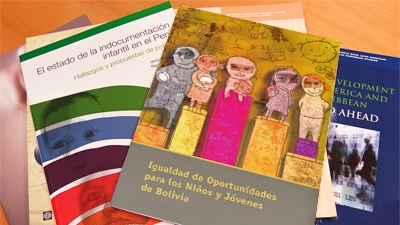In Bolivia, people who are under 20 today will account for 40% of the labor force in 2030, according to the study Equality of Opportunities for Bolivian Children and Youth.
La Paz, November 9, 2012. The Unit for Social and Economic Policy Analysis (UDAPE) of Bolivia’s Ministry of Development Planning and the World Bank jointly conducted the study “Equality of Opportunities for Bolivian Children and Youth” with a view to learning about opportunities of Bolivian children and youth in terms of their full development, education, health, nutrition, housing and other aspects. The study developed a method for measuring equality of opportunities for children and young people using the Human Development Index (HDI).
During the presentation of the study report, the Minister of Planning Development, Viviana Caro, said: “The social policies implemented in recent years have responded to an initial criterion of universality; we are currently transitioning to a second stage, where it is necessary to have new tools that enable us to target social policies to achieve the greatest impact. The HDI is an example of these tools. Based on this and data collected during the 2012 Population and Housing Census, it will be possible to assess, complement or refocus current programs.”
The report offers three basic messages:
- The leading cause of unequal opportunities in Bolivia is the difference between urban and rural areas. While there is also inequality due to gender, income, family structure, etc., the most important disparity is between the countryside and the city.
- Significant advances have been made in ensuring equal opportunity in Bolivia, particularly in the area of health, specifically in vaccinations. However, major delays continue in basic services such as sewage systems. Potosí lags far behind in this area compared with the country’s other eight departments.
- Bolivia has a sufficient public social budget to close these gaps.
According to Samuel Freije, World Bank senior economist and a co-author of the study, equality of opportunities for children and young people were measured because “those who are under 20 today will account for 40% of the total labor force in Bolivia in 2030. Thus, the opportunities provided to this group in terms of accumulation of human capital will define the labor supply.”
In keeping with the rights-based approach established in the Bolivian Constitution and taking into account indicators that were not systematically included in previous studies, the report presents HDI results for 17 indicators of access to basic opportunities in the areas of health, education and infrastructure at the national level for the period 1994-2008, and 24 indicators of access to health, education, infrastructure and social protection at the departmental level for the period 2003-2008.
For the World Bank Representative in Bolivia, Faris Hadad-Zervos, “…this study helps to identify areas where results can be maximized in a joint human development effort of the World Bank and the Plurinational State of Bolivia.”
The study found that the circumstances largely explaining the lack of equal opportunity include the area of residence and socioeconomic status of the parents. Therefore, reducing the urban-rural gap, especially in terms of housing facilities (sewage services, construction materials, etc.) needs to be prioritized in public policies. The focus should also be on combating domestic violence, which is disturbingly widespread in Bolivia.

